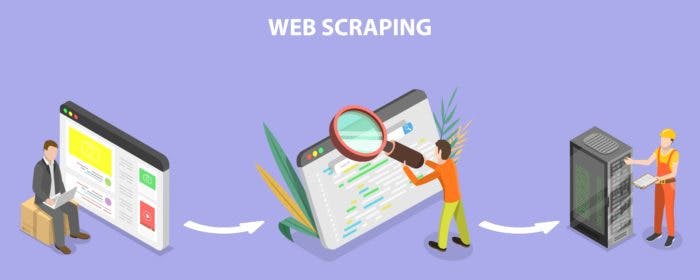Python is a popular programming language for a variety of applications. However, a few common questions people generally ask about the language are: Is Python used for data scraping? Is Python used for data wrangling?
Do you want to know more about the role Python plays in web scraping, data wrangling, and data processing? Keep reading!
In a recent interview, Shadrack Mwangi, a software engineer at Turing, answered popular questions related to Python, data scraping, and data processing.
Here are the top insights.
What is Python?

What is Python?
Python is an interactive, interpreted, high-level, object-oriented scripting language. Python is free to use and distribute. Also, Python has a simple syntax that is easy to understand.
Python can perform data analysis, web development, automation, scripting, software testing, prototyping, high-level data structures, data wrangling, and data scraping, among other tasks.
What is data scraping?

Data scraping with Python
Data scraping is the process of getting data from a website, enterprise applications, legacy systems, and databases into a spreadsheet or local file on your computer.
Data scraping tools or software can collect and import the data into a program to integrate it with your business workflow.
What are the benefits of data scraping?
Data scraping has several benefits, including cost-effectiveness, data accuracy, high speed, and ease of implementation.
What are the steps involved in data scraping?
Data scraping involves a series of steps, which include:
- Finding the URLs for scraping
- Inspecting the page
- Identifying the data for extraction
- Writing the necessary code
- Executing the code
- Storing the data
Which programming languages can developers use for data scraping and which one do you use?
Data scraping is a standard process that anyone can perform using different programming languages. Some programming languages used for data scraping are JavaScript, Python, Node.js, Ruby, and C#.
Answering the questions, Shadrack says: “I prefer Python because the scraping tools in Python are mature, and there is extensive support for scraping use cases.”
What role does Python play in data scraping?
Python offers a range of Python libraries and frameworks for data scraping. These include
- Beautiful soup: It is a library for pulling data out of HTML and XML files. Beautiful soup is ideal for screen scraping.
- LXML: It is a tool for C libraries- libxml2 and libxslt.
- Mechanical soup: It is a library that automatically stores cookies, follows links, and redirects and submits forms.
- Python Requests: It is the only non-GMO HTTP library with decompression, content decoding, SSL verification, and HTTP’s proxy support features.
- Selenium: It is a tool that offers a simple API to write acceptance or functional tests.
- Urllib: It is a package that helps you open and read different URLs.
- Scrapy: It is an open-source web crawling framework that can extract data using APIs.
Python enables smooth and automatic data scraping for different stages. This process includes interacting with the target destination to parse, extend, import, append and harvest data. Python allows you to automate the scripting, passing, and storage of data in one system.
Related Post: 12 Most Popular Python Frameworks
What are some of the challenges in data scraping?
“Data scraping can be challenging when new libraries are asynchronous in the loading stage and do not support client-side rendering. Also, websites have anti-scraping tools that can block IP addresses, proxy checks, and redirect captures,” says Shadrack.
To counter above mentioned challenges, Shadrack advises: “Firstly, you must identify the target for data scraping and then check whether the website has any anti-data scraping tools or not. After that, you need to use a mechanism to bypass the anti-scraping tools. You can use HTML and JSON format to extract data.”
He further adds: “You must get the IR locators to identify the location of data in the script, convert it, and pass it into storage. Also, check the subsequent URLs and make their duplicates using web drivers. Web drivers can simulate the entire browsing experience, including data loading and URL requests for smooth client-side rendering.”
“Another challenge can be authentication during data scraping. To face this challenge, you can create a session containing a username and a password. Log in to the website manually and use cookies to resolve the authentication issues. For complex authentication challenges, you must check the headers sent during authentication requests and compare them to the program you are utilizing,” suggests Shadrack.
What is the benefit of data scraping with Python for an end-user?
Data scraping with Python can help you understand target markets and analyze the competition. Businesses can find extensive data on listing sites and understand how market prices work. Also, they can fetch market prices, popular products, and customer preferences for a competitive advantage to increase their market share.
What is the future of data scraping with Python?
The future of data scraping with Python is quite bright, with many people browsing the internet and creating endless data structures. Businesses will require data scraping professionals to understand market behavior and build solid machine learning and artificial intelligence models.
What is data wrangling?
Data wrangling is organizing the scraped data into unique data sets. Data wrangling combines different data sets about a particular topic or subject. Data wrangling aims to make the data more accessible and easier to understand.
What role does Python play in data wrangling?
Python offers built-in features for various data wrangling tasks like grouping data, concatenating data, merging data, and joining data frames.
Which is the best Python library for data wrangling?
Pandas is a library written in Python exclusively for data analysis and wrangling. Pandas can intuitively work with labeled and relational databases. Built on two libraries, NumPy for mathematical operations and matplotlib for data visualization, Pandas provides excellent quantitative analysis. Many developer communities offer active support for Pandas.
What are Stemming and Lemmatization?
Stemming extracts the base form of words. For example, the stem is the word ‘drink’ for words like drinking, drinks, etc. So, by using stemming, one can accurately get the stems of different words from the search engine index.
Lemmatization searches for words after a morphological analysis. Using lemmatization, you can search for different inflection forms of the same word. Lemmatization uses a dictionary to establish different forms of the word in a similar context to provide accurate search results. For example, the lemma is the word run for different forms of run like ran, running, runs, etc.
Related Post: 8 Python Interview Questions Hiring Managers Love Asking Developers
What are Stemming and Lemmatization used for?
Stemming and Lemmatization can perform the following tasks:
- Text mining: Text Mining is analyzing texts written in natural language to extract high-quality information. Stemming and lemmatization are forms of natural language processing that look for similar patterns in the text to extract data accurately.
- Information retrieval: Stemming and Lemmatization help map documents for common topics and group them together. They help display accurate information retrieval from several search results.
- Sentiment analysis: Sentiment analysis is analyzing people’s reviews and comments about different products and services. Stemming and Lemmatization help with the text preparation process for sentiment analysis.
- Document clustering: Document clustering is applying cluster analysis to textual documents. However, the document requires tokenization and removal of stop words before document clustering.
Stemming and Lemmatization help reduce the number of unnecessary words. Also, they enforce tokenization to facilitate document clustering.
Which Python library helps with Stemming and Lemmatization?
Natural Language Toolkit is a Python library that works with natural language processing programs and data. NLTK can help with data classification, semantic reasoning, tokenizing, parsing and tagging.
Can I get a high-paying job with Python?
Turing helps Python developers get jobs in top US companies with great compensation and long-term career growth. Visit the Turing jobs page to know more.
Join a network of the world's best developers and get long-term remote software jobs with better compensation and career growth.
Ashwin Dua
Want to accelerate your business with AI?
Talk to one of our solutions architects and start innovating with AI-powered talent.



